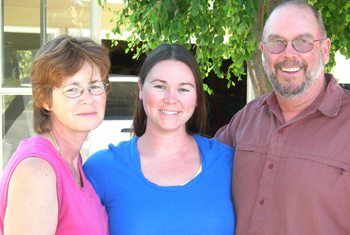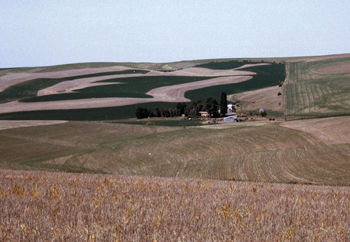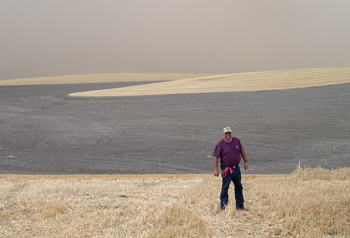Couple sow seeds to save soil on St. John farm and in USDA consulting
Lacking her husband’s farming heritage or any ties to farming, Ann Swannack knew little of soil erosion and conservation in the early years of their marriage.
Her husband, Steve, is the fourth generation to farm the land where he grew up 18 miles west of St. John, land settled by his English immigrant ancestors.
 |
| Ann, Stephanie and Steve Swannack |
Now, however, they share a commitment to conserving the soil of the Palouse and keeping it healthy.
Steve employs direct seeding practices on the 1,350 acres he farms.
Ann, as United States Department of Agriculture (USDA) conservationist, advises area landowners how to practice conservation on cropland, rangeland and irrigated land.
In addition to conserving soil as the primary resource on his 900 acres of cropland, Steve raises natural beef and hogs on 500 acres of scab rock land. A nearby land owner also pays him per acre to tend and harvest the crop on 250 acres.
“My father was always conservation minded,” Steve said. “It rubbed off on me.”
Steve sees his decision to do direct seeding as a stewardship decision.
 |
| Swannack farm rotation crops |
“God gave us the ground. We are blessed with it while we are here. It is good stewardship to protect the resource we have by reducing soil erosion on this land my family has farmed for more than 100 years,” said Steve, who attends St. John United Methodist Church.
“We no longer farm the original topsoil. Most is lost, even in the draws and low areas,” he said. “We plowed so long that the fertile soil that was once on the hills and eroded into the bottoms is now covered by the infertile soil that has washed down over it.”
He and Ann graduated from Washington State University in 1976, he in agronomy and soils, and she in animal science. She has since taken continuing education classes in agronomy.
After rearing their children, Ann began part-time work with the local Conservation District. She now works full-time with the Natural Resources Conservation Services of the USDA in Davenport and Ritzville.
While she has learned from Steve’s practices and shared those with others, she has also encouraged him to enter some of the conservation programs.
When he returned to farm more than 25 years ago, he began transitioning to direct seeding—also called “no-till” farming. Making the switch was at first expensive, because he had to buy new equipment. Now, Steve said, it is less expensive.
Not tilling the land reduces the number of trips he takes across the acres in his tractor.
Steve is a member of the Pacific Northwest Direct Seed Association in Moscow. The association’s website—www.directseed.org—points out that “increasing soil-stored carbon” benefits agriculture production and society.
About seven to 15 percent of area farmers use direct seeding, according to Russ Evans, director of the association.
 |
| Steve Swannack stands on direct-seeded field. Behind him, a neighbor's tilled field blows dust. |
Along with reducing carbon emissions released by tilling, he said direct seeding “improves soil health by maintaining surface residue that breaks down slowly and feeds soil bacteria and fungi, making the soil more alive. The soil is healthier and uses the nutrients more efficiently”
Russ said the residue retains more moisture in the soil, so there is less runoff and more moisture for the crop.
“Over the long term, we have anecdotal evidence that direct seeding results in farmers reducing use of herbicides after a transition of the weed and disease profiles,” Russ explained.
Along with direct seeding, Steve uses crop rotation.
His primary crop is wheat—winter, spring, soft, hard, white and red wheat—plus barley and triticale. He also plants canola and mustard, and has tried corn, soybeans and sunflowers as rotation crops to improve success with direct seeding. Other rotation crops include legumes, peas and lentils.
“We rotate them in to break disease cycles that can develop with direct seeding,” he said.
A trade off with not tilling may be more use of chemicals to inhibit weeds, along with crop rotation, he said.
“I’m selective about what chemicals I use and careful not to use persistent or long-acting chemicals that require waiting several years before legumes or broad-leaf plants will grow,” he explained.
In addition, Steve raises and sells about five steers and 45 hogs a year. Along with grazing, they are fed grass and alfalfa grown without chemicals. He gives them no antibiotics or hormones.
“I harrow the weeds out of the alfalfa without disturbing the roots so it grows back,” he said.
With mustard prices up from 10 cents a pound to 46 cents a pound, it’s now more profitable to raise the crops.
Steve delivers his harvested grain to a cooperative elevator in Lamont, where he stores it until he sells it, based on his regular monitoring of the market on the internet.
“Biofuel is part of the market pricing structure today, part of the price competition for acres,” he said, “but it will never be the total answer to the energy crisis. It’s a good component, whether made from alcohol from grains or from oil from oil seeds.”
Steve, however, balances that with recognition that there are a limited number of acres in the world for growing crops.
Ann is pleased that her career complements her husband’s farming.
“I’m able to promote practices we use,” she said.
While the 1985 Farm Bill mandates that land that is highly subject to erosion must be protected, she said it’s difficult to promote conservation in this region because many farm operators are not the landowners. Widows, children or grandchildren of farmers are now the owners.
Many producers who lease the land or are hired to farm the land focus on earning a profit or just surviving year to year, rather than seeing themselves as part of ongoing generations farming the land. Owners who do not live on or work the land also lose a sense of the land as heritage, she said.
“The Palouse had precious, deep, rich soil. Much of it is gone because of pressure to keep improving crop yield for profit, rather than maintaining the resource for future generations,” Ann said.
“Younger generations, who go to college, seek careers and settle elsewhere, are unaware if the operators are stewards or just concerned about profits,” Ann said.
She mentioned other factors:
Dry-land farms depend on climate. Limited rainfall limits the variety of crops they can use in rotation, explained Ann, who previously worked as agronomist serving 12 counties from Canada to Oregon.
Despite these factors, she is hopeful, because she sees a change in attitudes of landowners and operators as more decide that soil quality is a resource worth protecting.
“I feel blessed to be able to promote conservation,” she said. “Rather than promoting government programs, I feel I represent the soil as the resource.
“My faith sustains me through the frustrations,” said Ann who has taught Sunday school, vacation Bible school and Bible studies. She now leads a book group for adult education.
For both Steve and Ann, whose 27-year-old daughter lives in California, faith is key to their lives.
At church, Steve, who has sung in the church choir since high school, is now choir director and helps lead worship. He has a lay speaker’s certificate and preaches on occasion, too.
“I preach about our need to be prepared to step up to our call,” he said, “trusting that God gives us what we need.”
Weaving his love of music with preaching, he told of a sermon on the hymn, “In the Bleak Midwinter.” Not only do the words and poetry give meaning, but also the minor key of the music increases the impact of its message, Steve said.
In the Palouse, there are “bleak midwinter” days when “frosty winds” moan, as the hymn describes.
“We celebrate Christ’s birth in midwinter, when water is like stone, when snow falls on snow, when people live in hard times,” he said. “Out of the minor key, we are pointed to hope in the hard times, hope in Christ’s birth.
“I love the music, sound, feel and message of the song, and the reminder that in hard times there is hope,” said Steve.
He and Ann know hard times beyond the ups and downs of farming. Their 24-year-old son died Sept. 24, 2006, in a car accident near Pullman. He taught agriculture in Naches.
“When I feel blue or upset, I sit with a hymnal and sing old classics. It brings me peace.”
“If we did not have hope from our faith, where would we be?” he said.
For information, call 257-2411 or email swanfarm@worldnet.att.net.
Copyright © May 2008 - The Fig Tree




